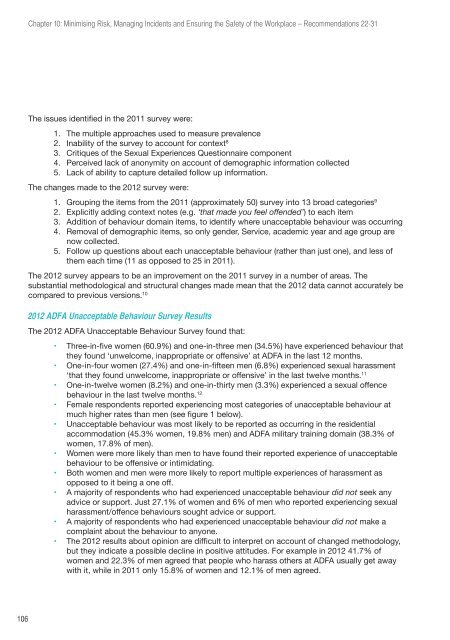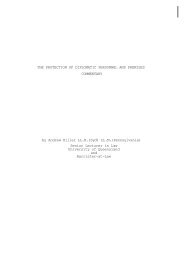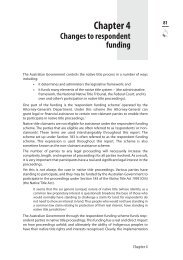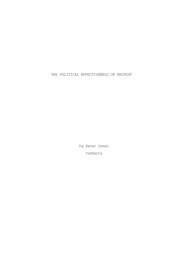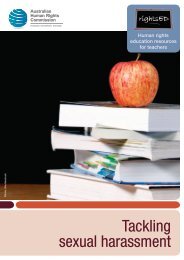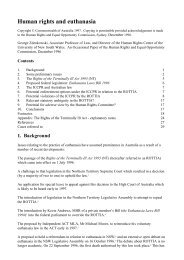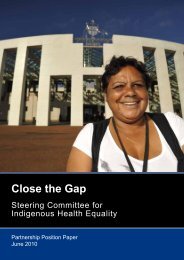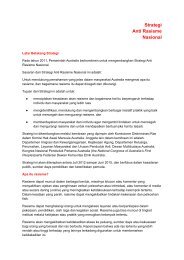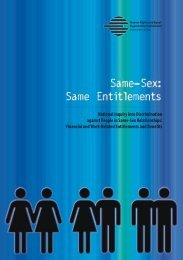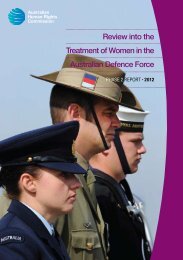Review into the treatment of women at the Australian Defence Force ...
Review into the treatment of women at the Australian Defence Force ...
Review into the treatment of women at the Australian Defence Force ...
- No tags were found...
Create successful ePaper yourself
Turn your PDF publications into a flip-book with our unique Google optimized e-Paper software.
Chapter 10: Minimising Risk, Managing Incidents and Ensuring <strong>the</strong> Safety <strong>of</strong> <strong>the</strong> Workplace – Recommend<strong>at</strong>ions 22-31The issues identified in <strong>the</strong> 2011 survey were:1. The multiple approaches used to measure prevalence2. Inability <strong>of</strong> <strong>the</strong> survey to account for context 83. Critiques <strong>of</strong> <strong>the</strong> Sexual Experiences Questionnaire component4. Perceived lack <strong>of</strong> anonymity on account <strong>of</strong> demographic inform<strong>at</strong>ion collected5. Lack <strong>of</strong> ability to capture detailed follow up inform<strong>at</strong>ion.The changes made to <strong>the</strong> 2012 survey were:1. Grouping <strong>the</strong> items from <strong>the</strong> 2011 (approxim<strong>at</strong>ely 50) survey <strong>into</strong> 13 broad c<strong>at</strong>egories 92. Explicitly adding context notes (e.g. ‘th<strong>at</strong> made you feel <strong>of</strong>fended’) to each item3. Addition <strong>of</strong> behaviour domain items, to identify where unacceptable behaviour was occurring4. Removal <strong>of</strong> demographic items, so only gender, Service, academic year and age group arenow collected.5. Follow up questions about each unacceptable behaviour (ra<strong>the</strong>r than just one), and less <strong>of</strong><strong>the</strong>m each time (11 as opposed to 25 in 2011).The 2012 survey appears to be an improvement on <strong>the</strong> 2011 survey in a number <strong>of</strong> areas. Thesubstantial methodological and structural changes made mean th<strong>at</strong> <strong>the</strong> 2012 d<strong>at</strong>a cannot accur<strong>at</strong>ely becompared to previous versions. 102012 ADFA Unacceptable Behaviour Survey ResultsThe 2012 ADFA Unacceptable Behaviour Survey found th<strong>at</strong>:• Three-in-five <strong>women</strong> (60.9%) and one-in-three men (34.5%) have experienced behaviour th<strong>at</strong><strong>the</strong>y found ‘unwelcome, inappropri<strong>at</strong>e or <strong>of</strong>fensive’ <strong>at</strong> ADFA in <strong>the</strong> last 12 months.• One-in-four <strong>women</strong> (27.4%) and one-in-fifteen men (6.8%) experienced sexual harassment‘th<strong>at</strong> <strong>the</strong>y found unwelcome, inappropri<strong>at</strong>e or <strong>of</strong>fensive’ in <strong>the</strong> last twelve months. 11• One-in-twelve <strong>women</strong> (8.2%) and one-in-thirty men (3.3%) experienced a sexual <strong>of</strong>fencebehaviour in <strong>the</strong> last twelve months. 12• Female respondents reported experiencing most c<strong>at</strong>egories <strong>of</strong> unacceptable behaviour <strong>at</strong>much higher r<strong>at</strong>es than men (see figure 1 below).• Unacceptable behaviour was most likely to be reported as occurring in <strong>the</strong> residentialaccommod<strong>at</strong>ion (45.3% <strong>women</strong>, 19.8% men) and ADFA military training domain (38.3% <strong>of</strong><strong>women</strong>, 17.8% <strong>of</strong> men).• Women were more likely than men to have found <strong>the</strong>ir reported experience <strong>of</strong> unacceptablebehaviour to be <strong>of</strong>fensive or intimid<strong>at</strong>ing.• Both <strong>women</strong> and men were more likely to report multiple experiences <strong>of</strong> harassment asopposed to it being a one <strong>of</strong>f.• A majority <strong>of</strong> respondents who had experienced unacceptable behaviour did not seek anyadvice or support. Just 27.1% <strong>of</strong> <strong>women</strong> and 6% <strong>of</strong> men who reported experiencing sexualharassment/<strong>of</strong>fence behaviours sought advice or support.• A majority <strong>of</strong> respondents who had experienced unacceptable behaviour did not make acomplaint about <strong>the</strong> behaviour to anyone.• The 2012 results about opinion are difficult to interpret on account <strong>of</strong> changed methodology,but <strong>the</strong>y indic<strong>at</strong>e a possible decline in positive <strong>at</strong>titudes. For example in 2012 41.7% <strong>of</strong><strong>women</strong> and 22.3% <strong>of</strong> men agreed th<strong>at</strong> people who harass o<strong>the</strong>rs <strong>at</strong> ADFA usually get awaywith it, while in 2011 only 15.8% <strong>of</strong> <strong>women</strong> and 12.1% <strong>of</strong> men agreed.106


